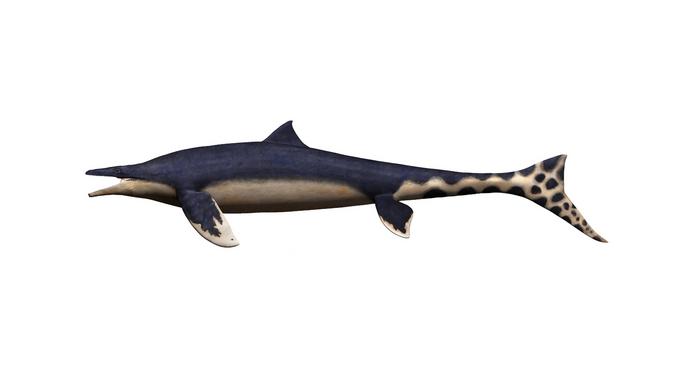Researchers have described a Japanese mosasaur the size of a great white shark that terrorized Pacific seas 72 million years ago.

Credit: TAKUMI
Researchers have described a Japanese mosasaur the size of a great white shark that terrorized Pacific seas 72 million years ago.
Extra-long rear flippers might have aided propulsion in concert with its long finned tail. And unlike other mosasaurs, or large extinct marine reptiles, it had a dorsal fin like a shark’s that would have helped it turn quickly and with precision in the water.
University of Cincinnati Associate Professor Takuya Konishi and his international co-authors described the mosasaur and placed it in a taxonomic context in the Journal of Systematic Palaeontology.
The mosasaur was named for the place where it was found, Wakayama Prefecture. Researchers call it the Wakayama Soryu, which means blue dragon. Dragons are creatures of legend in Japanese folklore, Konishi said.
“In China, dragons make thunder and live in the sky. They became aquatic in Japanese mythology,” he said.
The specimen was discovered along the Aridagawa River in Wakayama by co-author Akihiro Misaki in 2006. The specimen is the most complete skeleton of a mosasaur ever found in Japan or the northwestern Pacific, Konishi said.
“In this case, it was nearly the entire specimen, which was astounding,” Konishi said.
He has dedicated his career to studying these ancient marine reptiles. But the Japanese specimen has unique features that defies simple classification, he said. Its rear flippers are longer than its front ones. These enormous flippers are even longer than its crocodile-like head, which is unique among mosasaurs.
“I thought I knew them quite well by now,” Konishi said. “Immediately it was something I had never seen before.”
Mosasaurs were apex predators in prehistoric oceans from about 100 million years ago to 66 million years ago. They were contemporaries of Tyrannosaurus rex and other late Cretaceous dinosaurs that ruled the Earth. Mosasaurs were victims of the same mass extinction that killed off nearly all dinosaurs when an asteroid struck what is now the Gulf of Mexico.
Researchers placed the specimen in the subfamily Mosasaurinae and named it Megapterygius wakayamaensis to recognize where it was found. Megapterygius means “large winged” in keeping with the mosasaur’s enormous flippers.
Konishi said those big paddle-shaped flippers might have been used for locomotion. But that type of swimming would be extraordinary not only among mosasaurs but among virtually all other animals.
“We lack any modern analog that has this kind of body morphology — from fish to penguins to sea turtles,” he said. “None has four large flippers they use in conjunction with a tail fin.”
Researchers speculated that the large front fins might have helped with rapid maneuvering while its large rear fins might have provided pitch to dive or surface. And presumably like other mosasaurs, its tail would have generated powerful and fast acceleration as it hunted fish.
“It opens a whole can of worms that challenges our understanding of how mosasaurs swim,” Konishi said.
Journal
Journal of Systematic Palaeontology
DOI
10.1080/14772019.2023.2277921
Method of Research
Observational study
Subject of Research
Not applicable
Article Title
A new derived mosasaurine (Squamata: Mosasaurinae) from south-western Japan reveals unexpected postcranial diversity among hydropedal mosasaurs
Article Publication Date
11-Dec-2023
COI Statement
No conflicts to report.





